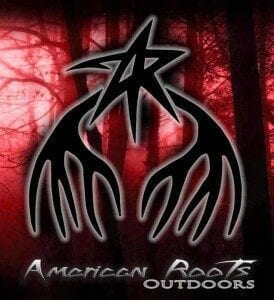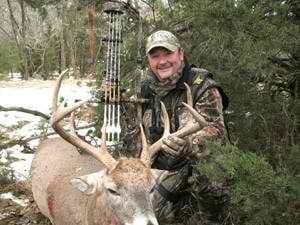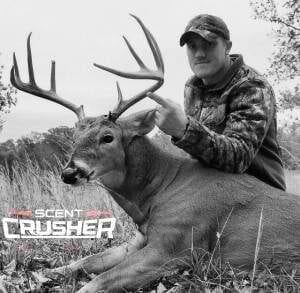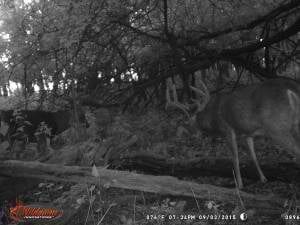LISTEN TO THE PODCAST HERE:
Alex & Ben ARO TV Hot Whitetails


Bruce: Hey folks, Part 1 was very interesting. We got the roots and the fiber of the new show that’s coming out with Alex Rutledge, American Roots Outdoor TV, and now Part 2, we’re gonna talk about something that’s on everybody’s mind right now, the rut.Alex & Ben ARO TV Hot Whitetails
The stages of the rut. There’s so much written, you can’t go anyplace on TV or magazine or the internet without somebody saying something about the rut. So, guys, what are you seeing right now in your neck of the woods as far as activity?
Alex: Okay, well I’m gonna start before Ben because I’m in South Central Missouri in the Ozarks in the Midwest. Our elevation is around 1,000 to 1,200 feet elevation. Our rut is actually kicking into pre-rut.
I’ve got mature buck with does already starting to guard does
I’ve got mature buck with does already starting to guard does. We are seeing many mature bucks biting the dirt the last two weeks. The scrapes are very active, the rubs are very evident, we’re starting to see bucks seeking. We got bucks showing up that hadn’t been here. So our bucks are ahead here. I’ve not stepped foot in the woods to hunt yet because I’m saving a certain farm that I got for my great niece Addie’s, we talked about earlier. I will start bowhunting after this youth weekend here in Missouri. But the success, the techniques people are using right now is finding scrape lines and rub lines and they’re finding these clusters of does and they’ve already fallen in place and the trail cameras are telling them where to go.
I personally use SPYPOINT venues as SPYPOINT and we continue to work with SPYPOINT is the plan for American Roots Outdoors. Trail cameras don’t lie, folks. If you’ll use this tactic, I’m about to share with you, you will see you’ll be more successful. We’re telling you to stay out of your woods only to pull your cameras one day a week, over food sources, over scrapes, over rubs, over watering holes, and you hunt by what the cameras tell you to hunt.
By keeping this low-pressure down
By keeping this low-pressure down and once you find that certain buck that’s on pattern, and you’ve set to studying and took a topographical map or an aerial photo of your property, and the wind is right how you can slip in there without spooking these deer, and you watch what I’m telling you, you will close the deal. And that’s my technique that I use to stay close to deer. Ben, what do you use, and what’s your deer doing in Tennessee?
Ben: Well, two weeks ago I noticed the first scrape mound and then we got a cold snap and I seen a lot of rubs, a lot of scrapes, I had five new bucks, saw ’em on camera last week before I come up here to Missouri so they’re definitely starting to move around and get curious about the does and what-not. My tactic that I’ve always used and it’s worked good for me, is I find the does and keep ’em there.
Well, two weeks ago I noticed the first scrape mound
Alex: Mineral licks.
Ben: Yeah, mineral licks.
Alex: We’re using rack ’em and stack ’em right now and all that. But anyway, mineral science. Deer feed where it’s legal.
Ben: Yeah, where it’s legal, to keep the does in your property and therefore when the rut kicks in, it’s a breeding ground. That’s always been my tactic and it’s worked really good for me. In Mentor, Tennessee where I hunt at, we’re getting better. This is the second year of the two buck limit, used to be three.
I’m seeing a difference. People are getting a little bit more mindful of what they shoot and are managing a little better I think it’s helping. I think at five years it’s getting there now. I see it all the time. Big deer are getting killed every year in Tennessee.
I’ve been blessed to take really good deer in Tennessee so I think it’s getting better and I’m looking forward to when I leave here and I’m getting home I’m real anxious to check my cameras. I got a [inaudible 00:03:40] right now, about a 150-inch pin so it’s kinda itching at me.
I’m real anxious to check my cameras
Alex: So, you hunt your trail camera?
Ben: Oh, yeah.
Alex: You let your trail cameras tell you when you need to hunt.
Ben: Oh, yeah. Definitely. I just put out two new cameras from SPYPOINT, they’re solar cameras and you don’t need no batteries at all so it’s pretty neat. You don’t have to worry about them running out. They’re awesome, awesome pictures, awesome video. It’s telling me a lot about my buck activity that’s coming in and it’s letting me know when I need to go in and hunt that deer.
If he’s showing up in daylight or whatnot. I have noticed that one in particular buck that I’m hunting he’s got two or three does that’s with him all the time now. Those does are staying in my spot, so it’s gonna happen.

Alex: Yeah, I’m gonna adlib to this if they ever outlawed trail cameras you would see less big bucks being killed.
Ben: Oh, yeah.
Bruce: Oh yeah, I agree with that.
Alex: And I pray to God that if someone gets elected we don’t want to get elected I hope that law doesn’t change. But anyway, that we can use trail cameras acrost America. People don’t only use trail cameras for deer hunting they use ’em for security purposes on their property, their homes. I’ve got cameras all around my property and on my home. I can tell you who comes down my gravel road, I can tell you who come in my gate, I can tell you who come in my door, I can tell you who come down my west, east, south, north boundaries of my property.
It’s just a great tool to have. You cannot ever have enough trail cameras. And that being said trail cameras is the most lethal weapon, in my opinion, one of the most lethal weapons you can have in your arsenal in harvesting animals.
Bruce: And folks, I’ll throw my two cents in here. The way people are building their hit lists, they start in July, August and they’re watching the bucks in velvet and they’re seeing age class deer, the deer that’s two and a half, now it’s three and a half, and they sorta kinda know because of the frame makeup, what deer it was.
Because if you pattern take a deer from his first year all the way through five and a half years, his frame, I’m talking about his horns, it just continues to grow unless he gets in an accident or something.

You can tell when they show up in trail cameras you can go, “Hey, that’s the big eight.” Or that’s Slippery Sam or that’s Splinter or that’s the Mahogany buck, all the essential bucks which I named, those are actual deer on my hit list. But when you think about that, they are, they are, they are. Mahogany buck he was a 160. I never got him. I got within 60 yards of him but I never closed the deal. But anyway, he’s still there as far as I know.
you get excited in July and August because you’re seeing,
But saying that, you hear it in my voice, you get excited in July and August because you’re seeing, I’m just gonna stick with the Mahogany buck because I know his frame and I’m going, “Oh, he’s still alive, he didn’t get hit by a car, he wasn’t taken in muzzleloader or gun season, he made it through the winter, no predation or anything, and he’s a healthy deer.”
Plus, he’s passing on his genes, because I know that bred X number of does. And the biologists can tell you actually how many does they do breed. That’s a conversation for the biologists. But when you look at your hit list, you build that and you stick with that when you find the sheds. Folks, hear what I’m saying, it’s a 365-day hunt. It really is. You guys, do you agree with that or not or?
it’s a 365-day hunt. It really is.
Please subscribe, rate and review each @WhitetailRendez podcast at http://getpodcast.reviews/id/1032967565
